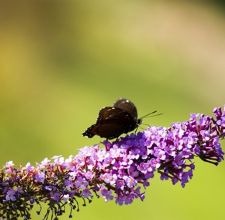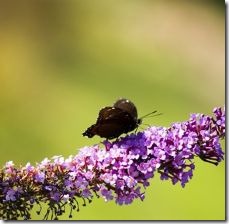Butterfly weeds—fast growing and spreading and difficult to remove—pose a threat to native plants and soils in the Pacific Northwest region of the United States, Great Britain and New Zealand. Governments in Oregon and Washington designated it as a noxious weed in the mid-2000s.
Features
-
Butterfly bush or butterfly weed, known scientifically as Buddlejaceae, grows arching branches that can reach 15 feet in height, according to the Washington State Noxious Weed Control Board website. It produces tapered purple flower spikes amid lightly hair-covered leaves and stems. The bark of mature stems turns from green to grayish brown and peels off over time.
The flowers, produced in mid- to late-summer, look like small pointed lilacs, according to the Oregon Department of Agriculture Plant Division website.
Significance
-
Also known as summer lilac, the butterfly bush had been a popular ornamental landscape plant, prized for its fast-growing nature and showy flowers. But its heavy production of lightweight, easily spread seeds resulted in excessive wild growth along roadways, railroad tracks and in pastures, according to the Washington State website. The tree grows into tangled thickets along river banks and in midstream gravel bars, crowding out native plants and changing soil nutrient levels.
Butterfly weeds also pose threats to dry meadows and open dunes, according to the Oregon Department of Agriculture Plant Division. In newly logged areas, butterfly weed growth prevents re-forestation by native tree species.
Spread
-
Seeds spread by wind or water. Trees begin producing seeds in their first year and more than 80 percent of them germinate. One type of butterfly bush known as Potter’s Purple produces 40,000 seeds for each flower, according to the Washington State website.
New shoots sprout from the spreading roots of mature plants. New plants also grow from pieces of existing plants that fall to the ground.
Controls
-
Butterfly bushes resist most removal efforts. Even if cut back to the roots, the plant re-sprouts from cut areas of the root and new shoots grow from any cut stems left on the ground, according to the Washington State website.
The Washington State Noxious Weed Control Board recommends cutting flowers off of butterfly bushes before seed production, usually in the fall. The flowers, seeds and any cut branches should be disposed of or burned to prevent new growth.
Distribution
-
In Washington State, the butterfly bush mainly thrives in the coastal and western parts of the state. In Oregon, researchers have found invasive growth of butterfly bush in the Willamette National Forest and along the state’s southern coast.
Officials in Great Britain consider the butterfly bush one of the top 20 invasive plants.
Considerations
-
Digging up the plant may create more problems by loosening seeds and shoots that lead to new plants, according to the Washington State website.
Efforts to control the plant in Oregon include eliminating it in the wild, but not from yards or in landscapes, according to the Oregon State University extension service website. Education programs encourage homeowners to control their butterfly bush growth and seed production, dig up seedlings and not grind plant stems for mulch.


Deprecated: strpos(): Passing null to parameter #1 ($haystack) of type string is deprecated in /home/agriviek8Qv/agriviet.net/public_html/wp-includes/comment-template.php on line 2522